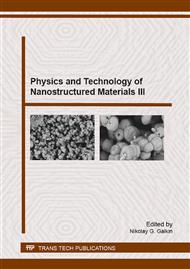[1]
V.G. Solovyov, S.D. Khanin, Dimension effects in nanostructures based on regular porous matrices, Bulletin of Herzen State Pedagogical University of Russia. 8 (2004) 10.
Google Scholar
[2]
O.V. Lozovaya, M.R. Tarasevich, V.A. Bogdanovskaya, I.V. Kasatkina, A.I. Shcherbakov, Electrochemical synthesis, studies and modification of TiO2 nanotubes, Prot. Met. Phys. Chem. 47 (2011) 48-53.
DOI: 10.1134/s2070205111010114
Google Scholar
[3]
W.W. Zhao, Z.Y. Ma, D.Y. Yan, J.J. Xu, H.Y. Chen, In situ enzymatic ascorbic acid production as electron donor for CdS quantum dots equipped TiO2 nanotubes: a general and efficient approach for new photoelectrochemical immunoassay, Anal. Chem. 84 (2012).
DOI: 10.1021/ac3028799
Google Scholar
[4]
H. Li, J. Li, Q. Xu, Zh. Yang, X. Hu, A derivative photoelectrochemical sensing platform for 4-nitrophenolate contained organophosphates pesticide based on carboxylated perylene sensitized nano-TiO2, Anal. Chim. Acta. 766 (2013) 47-52.
DOI: 10.1016/j.aca.2012.12.038
Google Scholar
[5]
M.G. Kutsev, G.M. Kuz'micheva, L.N. Obolenskaya, E.V. Savinkina, Molecular interaction between dna molecules and nanoscale modifications of titanium dioxide with the structures of anatase and η-TiO, J. Phys. Chem. A. 86 (2012) 1822-1826.
DOI: 10.1134/s0036024412110179
Google Scholar
[6]
J.M. Macak, A. Ghicov, R. Hahn, H. Tsuchiya, P. Schmukia, Photoelectrochemical properties of N-doped self-organized titania nanotube layers with different thicknesses, J. Mater. Res. 21 (2006) 2824 – 2828.
DOI: 10.1557/jmr.2006.0344
Google Scholar
[7]
D. Gong, C.A. Grimes, O.K. Varghese, Titanium oxide nanotube arrays prepared by anodic oxidation, Mater. Res. Soc. 16 (2001) 3331-3334.
DOI: 10.1557/jmr.2001.0457
Google Scholar
[8]
D.I. Petukhov, I.V. Kolesnik, A.A. Eliseev, A.B. Lukashin, Yu.D. Tretyakov, Synthesis and study of the properties of porous TiO2 films obtained through anodic oxidation. Russ. J. of Alternative Power Supply and Ecology. 1 (2007) 65-69.
Google Scholar
[9]
V. Zwilling, E. Darque-Ceretti, A. Boutry-Forveille, D. David, M.Y. Perrin, M. Aucouturier, Structure and physicochemistry of anodic oxide films on titanium and TA6V alloy / Surf. Interface Anal. 27 (1999) 629–637.
DOI: 10.1002/(sici)1096-9918(199907)27:7<629::aid-sia551>3.0.co;2-0
Google Scholar
[10]
N.V. Korovin, E.V. Kasatkin, Electrocatalyzers of Electrochemical Facilities, Russ. J. Elecrochem. 29 (1993) 448-460.
Google Scholar
[11]
D.V. Malevich, A.F. Mazetz, V.B. Drozdovich, I.M. Zharskii, Influence of preparation method of Ptmet/Ti catalyst on some properties of active phase, Russ. J. Appl. Chem. 70 (1997) 1330-1333.
Google Scholar
[12]
G.I. Marinina, M.S. Vasilyeva, A.S. Lapina, O.D. Arefyeva, N.B. Kondrikov, The metal–oxide electrodes formed plasma electrolytic oxidation for the potentiometric determination of alkalinity and chlorides in waters technogenic, Russ. J. Analytics and Control. 17 (2013).
DOI: 10.15826/analitika.2013.17.3.003
Google Scholar
[13]
G.I. Marinina, M.S. Vasilyeva, A. Yu. Ustinov, V.S. Rudnev, Electroanalytical properties of metal–oxide electrodes formed by plasma electrolytic oxidation, J. Electroanal. Chem. 689 (2013) 262–268.
DOI: 10.1016/j.jelechem.2012.10.032
Google Scholar
[14]
A. I. Shcherbakov, I. V. Kasatkina, V. E. Kasatkin, V. I. Zolotarevskii, Impedance of titanium electrode with a nanotube anode, Prot. Met. Phys. Chem. 50 (2014) 195-199.
DOI: 10.1134/s2070205114020154
Google Scholar
[15]
J. M. Macak, H. Tsuchiya, L. Taveira, S. Aldabergerova, P. Schmuki, Smooth anodic TiO2 nanotubes, Angew. Chem. Int. Ed. 44 (2005) 7463–7465.
DOI: 10.1002/anie.200502781
Google Scholar
[16]
D. Regonini, A. Jaroenworaluck, R. Stevens, C.R. Bowen, Effect of heat treatment on the properties and structure of TiO2 nanotubes: phase composition and chemical composition, Surf. Interface Anal. 42 (2010) 139–144.
DOI: 10.1002/sia.3183
Google Scholar
[17]
B.B. Damaskin, O.A. Petrii, G.A. Tsirlina, Electrochemistry, Khimia, KolosS, Moscow, (2006).
DOI: 10.1134/s1023193507080186
Google Scholar
[18]
N. F. Razina, Oxydic electrodes in aqueous solutions, Science, Almaty, (1982).
Google Scholar


